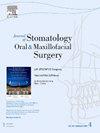将口腔标本作为准确分析元基因组的工具:试点研究
IF 2
3区 医学
Q2 DENTISTRY, ORAL SURGERY & MEDICINE
Journal of Stomatology Oral and Maxillofacial Surgery
Pub Date : 2024-10-01
DOI:10.1016/j.jormas.2024.101991
引用次数: 0
摘要
目的:急性口腔粘膜损伤以及其他炎症过程似乎与口腔微生物群的菌群失调有关。由于需要研究口腔微生物组的变化,我们假设哪种类型的样本最能代表整个人类口腔微生物组:我们进行了一项横断面观察研究。六名健康的成年参与者分别提供了三种不同类型的样本,包括唾液、口腔漱口水和粘膜活检组织。我们使用 Illumina MiSeq 技术对 18 份样本的 V3-V4 区域进行了 16S rRNA 测序:结果:参与者年龄为 27 ± 6.3 岁。与整个未刺激唾液和口腔黏膜组织相比,口腔漱口水样本中的细菌α多样性更高(p=0,005)。然而,唾液样本中已确定物种的相对丰度为 56%,口腔漱口水中为 30%,组织样本中仅为 1%:这项研究发现,每种样本的口腔微生物组组成都存在差异。结论:这项研究发现了每种样本在口腔微生物组组成上的差异。当需要更高的α多样性时,应选择口腔冲洗样本,而整个未刺激唾液样本更适合细菌DNA的大量存在:临床相关性:研究结果表明,由于微生物组的组成存在差异,正确选择最佳口腔样本类型对于微生物组研究非常重要。本文章由计算机程序翻译,如有差异,请以英文原文为准。
Oral specimens as a tool for accurate metagenomic analysis: A pilot study
Objectives
Acute oral mucosal damage, as well as other inflammatory processes seem to be related to dysbiosis of the oral microbiome. The need to study changes in the oral microbiome led us to hypothesize what type of sample would provide the most representative picture of the entire human oral microbiome.
Materials and methods
An observational, and cross-sectional study was carried out. Six healthy adult participants provided 3 different sample types each, that included saliva, oral rinse and mucosal biopsy tissue. We performed 16S rRNA sequencing of the V3-V4 region of the 18 samples using Illumina MiSeq technology.
Results
Participants were 27 ± 6,3 years old. Bacterial alpha diversity was higher in oral rinse samples compared to whole unstimulated saliva and oral mucosa tissue (p = 0,005). However, saliva specimens showed a 56 % relative abundance of identified species followed by a 30 % in oral rinse and only 1 % in tissue samples.
Conclusions
This study found differences on oral microbiome composition for each type of sample. Oral rinse should be chosen when higher alpha diversity is needed, whereas whole unstimulated saliva should be more appropriate for larger amount of bacterial DNA.
Clinical relevance
The results obtained demonstrate the importance of a correct choice of the optimal type of oral sample for microbiome studies due to the differences found in its composition.
求助全文
通过发布文献求助,成功后即可免费获取论文全文。
去求助
来源期刊

Journal of Stomatology Oral and Maxillofacial Surgery
Surgery, Dentistry, Oral Surgery and Medicine, Otorhinolaryngology and Facial Plastic Surgery
CiteScore
2.30
自引率
9.10%
发文量
0
审稿时长
23 days
 求助内容:
求助内容: 应助结果提醒方式:
应助结果提醒方式:


